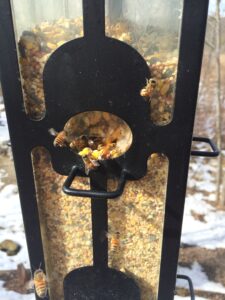I’ve been keeping bees since 2008, and this is the first time I’ve been able to wish them a Merry Christmas in person.
On one hand—that’s a good thing. Until I aggressively treated Varroa (this was the first year that I would classify my treatments as aggressive), I experienced the typical late fall die-offs that Varroa cause. Didn’t have any die-offs this fall, so I actually had LOTS of bees to greet, and lots of opportunities to greet them as they zipped about seeking food. Want to attract their attention? Wear flower colors when they’re out flying in the winter, you’ll have dozens of friends uncomfortably crawling all over your shirt.
On the other hand, seeing bees actively checking out any and everything in December is likely not a good thing. That activity burns lots fuel, which they’re replenishing by eating their winter stores. In a typical Michigan winter, they’re tightly assembled and not burning much fuel. They cluster for warmth in practically a comatose state, shivering efficiently to keep the queen warm.
Bottom line: they’ve consumed more than normal the last three “balmy” months, and I hope they don’t run out of stores before the earth’s grocery stores re-open.
What can we do about it? As always, read and research to gain understanding about the issues, and figure out what you want to do about it. Here’s what I’m doing about it, and some thoughts.
- Worrying lots, although that probably isn’t helping anyone.
- Feeding 2:1 sugar syrup in an open-feed situation on days they’re out flying. By “flying” – I mean not just a half dozen bees leaving the hive for brief cleansing flights. Look for foraging behavior, and a dozen or more actively flying. If the temperature is sinking or about an hour before sunset, you may want to put the feed away. I’ve found if I leave it out, there’s always a handful of foragers who didn’t leave in time and perished from cold at the feeder.
- Peeking at their emergency food ceiling to ensure something is still there. If it is 20-40 degrees, you can crack the top and assess in 2-4 seconds if they’ve devoured most of it, or what they still have. (You have a candy board at the top, or used the Mountain Camp Method, right?) If the emergency feed method is greatly diminished, add some sort of supplemental feed—being very efficient if weather demands. Note: we did this a lot last week, and in some cases found hundreds of bees chowing on their Mountain Camp. We surmise it was because it was warm enough for them to be roaming about the hive (40-65 degrees outside, but raining), and they decided to dash upward for food. That may be wishful thinking. Some of our hives seemed alarmingly light, so the Mountain Camp may be the extent of their larder at this point. (If “Mountain Camp” is an unfamiliar term, check out my hand-out on it in the Publications section of this site.)
- Providing honey. Best thing for bees to eat? We’d saved some honey frames, and we took advantage of last week’s warm weather to add those to the top of a few colonies that seemed light. Remember, bees are “chimney eaters” – they generally cluster in the bottom boxes and consume the honey about and around them as it is softened by the heat of the cluster.
We also put out small amounts of honey where we open-fed, although the bees seemed to prefer the 2:1 sugar syrup.
- Providing pollen substitute on days when they’re out flying—and this is not without some angst. You see, pollen stimulates brood rearing, and a problem with rearing brood in January is that there may not be enough bees to keep the bees-to-be warm while they’re developing … so we don’t want the queen to prematurely start laying. However, my bees (yep, pretty sure they were mine) were attacking my neighbor’s bird feeder (containing cracked corn), and carrying off what appeared to be pollen, so I’m assuming they want some. If winter shows up as expected this week, I probably won’t have to worry any longer as they won’t be flying anyway.
- Checking out other things because I was there. During one Mountain Camp peek, I found mold growing—indicating the hive was not sufficiently vented. (Drilled a few more half inch holes in the upper hive bodies.) I scraped dead bees out the doorway of a few others, because it’d been too cold for them to carry out the bees dying from (hopefully just) natural attrition. I looked about for limbs that may be ready to fall or other things amiss, and my just looking about was rewarded by—ALLELUIA—finding a hive tool I misplaced last summer.
Winter as we tend to think of it (freezing temperatures) is allegedly seeping into our area soon. I’m not looking forward to shoveling the drive, slipping on ice, and hearing the furnace run. However, I will be relieved when the temperatures are more conducive to our bees efficiently using their waning stores, so I can return to my normal worrying about them, things like – are they missing me as much as I’m missing them?
Happy New Year everyone, and please use this bee off-season to read, ponder and plan for Spring. It’ll be here before we know it, right? 🙂


